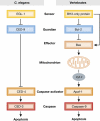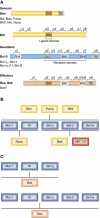Deciphering the rules of programmed cell death to improve therapy of cancer and other diseases
- PMID: 21863020
- PMCID: PMC3173800
- DOI: 10.1038/emboj.2011.307
Deciphering the rules of programmed cell death to improve therapy of cancer and other diseases
Abstract
Apoptosis, the major form of programmed cell death in metazoan organisms, plays critical roles in normal development, tissue homeostasis and immunity, and its disturbed regulation contributes to many pathological states, including cancer, autoimmunity, infection and degenerative disorders. In vertebrates, it can be triggered either by engagement of 'death receptors' of the tumour necrosis factor receptor family on the cell surface or by diverse intracellular signals that act upon the Bcl-2 protein family, which controls the integrity of the mitochondrial outer membrane through the complex interactions of family members. Both pathways lead to cellular demolition by dedicated proteases termed caspases. This review discusses the groundbreaking experiments from many laboratories that have clarified cell death regulation and galvanised efforts to translate this knowledge into novel therapeutic strategies for the treatment of malignant and perhaps certain autoimmune and infectious diseases.
Conflict of interest statement
The authors declare that their research at the Walter and Eliza Hall Institute includes a joint programme with Genentech Inc. and Abbott Labs to develop novel anti-cancer therapeutics.
Figures





References
-
- Allan JM, Travis LB (2005) Mechanisms of therapy-related carcinogenesis. Nat Rev Cancer 5: 943–955 - PubMed
-
- Bardwell PD, Gu J, McCarthy D, Wallace C, Bryant S, Goess C, Mathieu S, Grinnell C, Erickson J, Rosenberg SH, Schwartz AJ, Hugunin M, Tarcsa E, Elmore SW, McRae B, Murtaza A, Wang LC, Ghayur T (2009) The Bcl-2 family antagonist ABT-737 significantly inhibits multiple animal models of autoimmunity. J Immunol 182: 7482–7489 - PubMed
Publication types
MeSH terms
Grants and funding
LinkOut - more resources
Full Text Sources
Other Literature Sources

